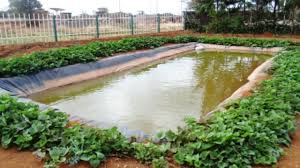
Instead of buying nitrogenous fertilisers for his vegetable garden, Dickson Mosota has eliminated these costs by tapping fish pond water for irrigation as well as for the supply of nutrients.
Fish excrements are rich in urea, which is a compound of nitrogen and other elements.
Nitrogen is one of the basic mineral elements responsible for the vegetative growth in crops. It is a macro nutrient in photosynthesis, the process of making food in green plants.
From his integrated farming at Gesonso, Kisii County, the farmer realised that when he used the water from his integrated fish pond, the vegetables on top of the chicken and rabbit hatch did well.
Chickens and rabbits drop their faecal matter into the water to support the growth of algae for the fish. When the fish excrete, the accumulating waste has other minerals elements that accelerate the growth hormones in the crops. Nitrogen is the main component in urea.
RELATED CONTENT: Prisons officer helps farmers set up integrated backyard fishponds
The farmer drains the 4m by 8m pond monthly besides the regular circulation.
Besides fish, the excess faecal matter from the five chickens and three rabbits also enriches the water. The sediments are deposited at the base do the pond.
Chicken droppings are rich in potassium and phosphorus.
RELATED CONTENT: Human urine best fishpond fertiliser, research says
The drained water is allowed to enter his irrigation system serving a plot of kales, and black night shade or managu.
“I am harvesting more vegetables than I used to when I applied commercial fertilisers. I am glad that the water is not going to waste given that I get it at a cost. The fish and chickens are adding value to the water,” Mosota said during the 2017 Kisii Agricultural Society of Kenya Show.
From the plot, where he used to harvest about 55kg after 10 days, the output has risen to between 80kg and 90kg over the same period. In five days after application, the leaves turn dark green. Their size is also bigger than the ones he used to harvest before.
RELATED CONTENT: Fish pond waste water increases milk yields by three litres
The pond has a polythene lining, which only allows the water to be circulating. The solid particles and any other organic matter sediment below the pond for later use.
On this plot, the farmer spend about 10kg of CAN fertiliser every month. He is no longer buying the fertiliser.